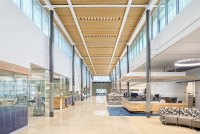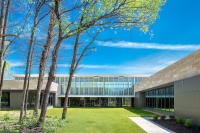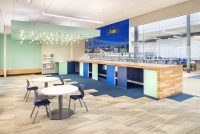Building Green Libraries
The Indianapolis Public Library, Ind.
Innovation Synopsis
The Indianapolis Public Library (IndyPL) identified the need for a community library in one of Indianapolis’ busiest traffic corridors. IndyPL leveraged the expertise of a local architecture firm and urban hardwood lumber company to maximize an energy efficient, green facility that utilized many of the trees originally occupying the branch’s land.
Challenge/Opportunity
IndyPL sought to use the development of the branch as a beacon in a historically underserved community and bolster the identity of both the local community and the library system. The branch was built using 17 onsite trees with the resulting material being incorporated throughout the branch. The outcome has been a beautiful new heartbeat of the community created using resources from the neighborhood which can now be used to teach messages about recycling and environmental sustainability.
Key Elements of Innovation
Indy Urban Hardwood and KrM Architecture used an estimated 30,000 pounds of material from 17 hardwood trees harvested onsite to create 1,760 board feet used in the branch including shading slats, a children’s tunnel, maple circulation desk, accents throughout the building and 14 custom-designed elm tables. The project is designed to use 47% less energy than the local code baseline, utilizes water management features, adds neighborhood pedestrian path connections and bus stops, and will receive LEED Silver, version 4 certification.
Achieved Outcomes
Nearly 62,000 patrons have visited the new innovative branch since it opened on December 15, 2018. The branch has been responsible for over 135,000 circulations, 107 programs, 5,290 program attendees and constant study room usage, and provides a hands-on teaching tool for how our environment and natural resources can be more effectively leveraged. This 2019 AIA Merit Award-winning branch will help the youth of this traditionally underserved neighborhood learn the importance and value of natural resources all around them.



